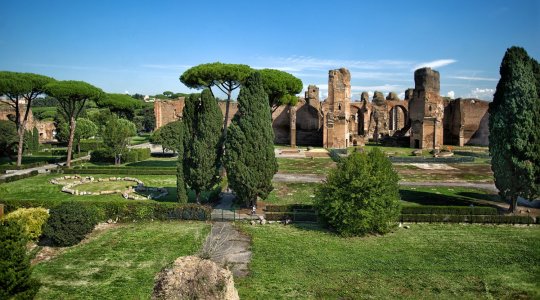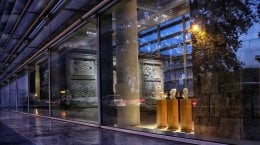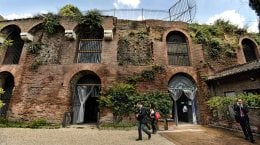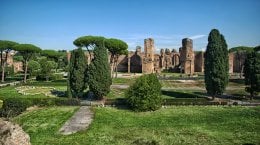Official Reseller Rome and Vatican – Jubilee 2025
Baths of Caracalla
The Baths of Caracalla or Antoniniane constitute one of the most magnificent examples of imperial baths in Rome, still preserved for most of their structure and free from modern buildings.

The Baths of Caracalla: history
The Baths of Caracalla, also called Antoniniane, are the most ancient find of the Roman imperial period as far as thermal baths are concerned. This structure, in fact, has been perfectly preserved over the years and centuries.
The Baths of Caracalla were built at the behest of the emperor on the Aventine hill and a short distance from the Via Appia around the years 212 and 216. They were considered the largest and most impressive baths of Rome until 306 when the Baths of Diocletian were inaugurated.
As mentioned, the construction of the Baths of Caracalla began in 206 under Settimo Severo but were opened to the public and inaugurated only later for the attention of his son Caracalla in 216. In fact, the successors Eli Gabalo and Alessandro Severo took care of completing the work of construction.
To allow the water supply of the baths, in 212 the so-called branch of the Acqua Marcia was created, namely the third aqueduct of ancient Rome. However, the last alterations to the structure and the small restorations were carried out only later under the emperors Aureliano, Diocleziano, Teodosio and Teodorico.
After a period of great splendor, however, the Baths of Caracalla were abandoned. Its use changed according to the needs, passing from hostels for travelers and foreigners to agricultural land for vineyards up to source of valuable materials. In fact, there are many parts used for the original construction that were taken from the decorations, from the architectural elements such as beams and columns but also from materials of great value such as marble and metals for the construction of other buildings. The best known and obvious examples are certainly the Duomo of Pisa and the Basilica of Trastevere, which contain parts of the most important architectural structures.
During the pontificate of Pope Paul III, in the 16th century, numerous excavations affected the area of the baths. They brought to light statues of prestige that were located in numerous museums. Finally, in 1563 the last column was taken, which was subsequently donated to Pope Pius IV. He decided to place it in Piazza Santa Trinità in Florence. Here he took the name of Colonna della Giustizia.
Open from the last Sunday of October to February 15 from 09.00 a.m. – 4.30 p.m.
From February 16 to March 15 from 09.00 a.m. – 5.00 p.m.
From March 16 to the last Saturday of March from 09.00 a.m. – 5.30 p.m.
From the last Sunday of March to August 31 from 09.00 a.m. – 7.15 p.m.
From September 1 to September 30 from 09.00 a.m. – 7.00 p.m.
From October 1 to the last Saturday of October from 09.00 a.m. – 6.30 p.m.
Monday 09.00 a.m. – 2.00 p.m.
Closed January 1, December 25
Ticket office
Closes an hour earlier
The Baths of Caracalla are located in Viale delle Terme di Caracalla 52, Rome. They are easily reachable by getting off at the Circo Massimo stop using Metro Line B or with bus n. 760 and bus n. 628.
In general, near the thermal baths there are numerous bus and tram stops that make connections to the structure convenient departing from multiple areas of Rome.
In the immediate vicinity of the Baths of Caracalla it is possible to visit he Colosseum, which is easily reachable on foot (about 1.2 kilometers away), the Roman Forum (about 1.3 kilometers away) and the famous Circo Massimo. Moreover, the Church of San Sisto Vecchio, the Church of San Cesareo in Palatio and the famous Bocca della Verità are near the Baths of Caracalla.
Visiting the Baths of Caracalla
While visiting the Baths of Caracalla, you will notice the structural subdivision that has a central body with a rectangular plan that is divided into several rooms, and a large external area that was initially protected by a fence of columns and arcades. The most important rooms are located on the central axis while the others are laterally positioned symmetrically to the right and left.
It is possible to admire the internal tour of the Baths of Caracalla’s patrons that started from the locker rooms, going through different areas where to practice gymnastics and train the body, and finishing with saunas to purify the body.
The first thermal room was the so-called calidarium: a room of large size with a circular plan. It housed a large hot tub centrally located and was equipped with numerous windows that allowed light and heat to filter inside the structure. To access the pools of cold water called frigidarium, it was necessary to cross the tepidarium. Moreover, the Baths of Caracalla were equipped with a large outdoor swimming pool called natatio. Its majestic size of 50 meters long and 19 meters wide makes it one of the largest pools in the city of Rome.
The decorations played a fundamental role in the complex of the Baths of Caracalla. Currently, only a few can be admired during the visit. Precious marbles, precious materials and metals, colored mosaics and statues are just some of the ornamental elements present.
Tourists can also visit the metro passages of the Baths of Caracalla once dedicated to an ingenious and complex system of water supply and heating. The museum built in this area also houses forty-five marble departments and, on top of that, visitors will be able to admire the Mitreo, the water mill responsible for regulating the water.
Altogether, the visit of this area is divided into a tour of two parallel galleries. In these, an Antiquarium in which various findings are exhibited, such as capitals, friezes, low reliefs and various decorations present initially in the construction was created.
Colosseum, Circus Maximus



